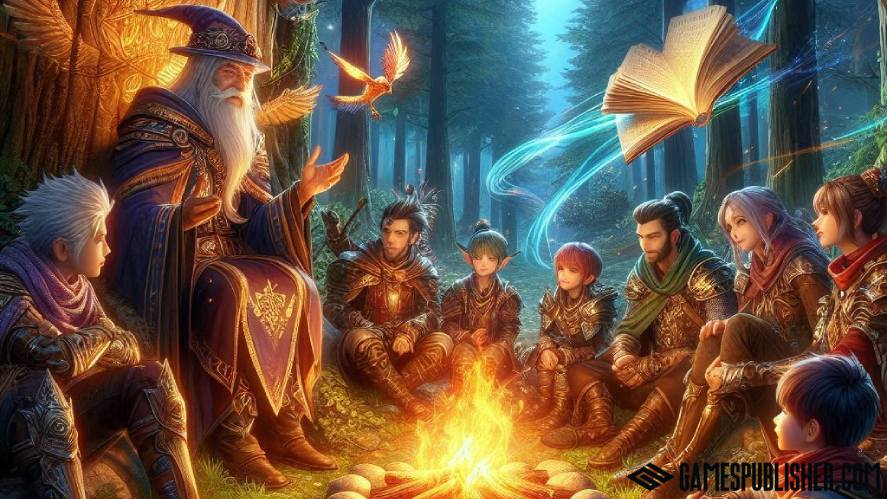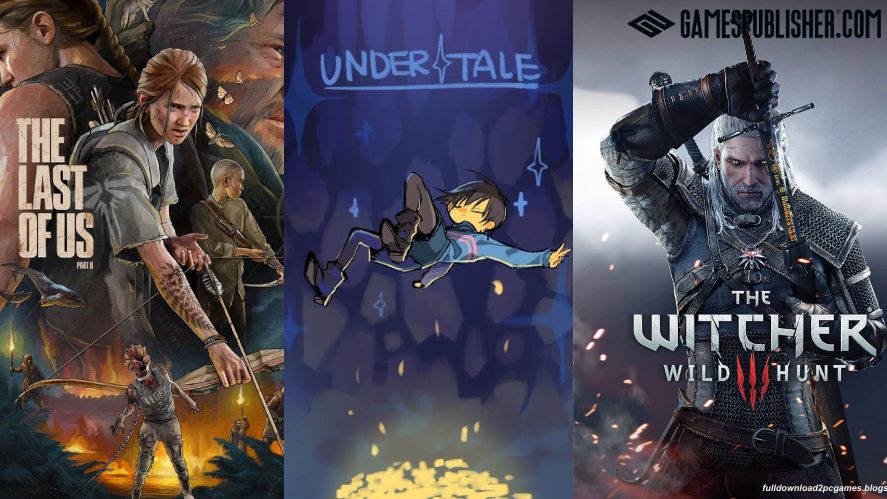Welcome to Gamespublisher.com! Here, you can dive into the exciting world of game development, sharing valuable insights about how games are published.
In the gaming industry, a big part of making great video games is something called narrative design.
An excellent narrative design isn’t just about having a fun story; it also helps keep players interested and wanting to play more.
When the story is well done, players feel more connected and excited about the gaming.
In this article, we’ll explain the main parts of video games and storytelling, see how these parts affect how players feel and think, and give some practical strategies for game developers on how to make a story that grabs players’ attention.
These things will help video game publishers create games that are not only enjoyable but also memorable and engaging for players.
Understanding Narrative Design in Video Games
Narrative design is crucial to creating games, focusing on the story, world, characters, and dialogue.
Unlike storytelling in movies or books, storytelling in video games involves the player making choices that affect the story.
What is Narrative Design?
Narrative design refers to the careful planning and telling of a story in video games, which ultimately shapes and develops the plot, the primary sequence of events that unfolds throughout the game’s storyline.
Narrative design also builds the world where the story takes place, making it feel natural and detailed.

It works on developing characters, giving them unique personalities and backgrounds so they seem believable.
The characters’ dialogues must also be designed appropriately and closely to the plot.
Difference from Traditional Storytelling
Video game narrative is different from storytelling in movies or books mainly because of how it involves the player.
In video games, the story often changes based on the player’s choices.
This means players can affect how the story unfolds and what happens next.
For example, in a game, a player might choose to help a character or ignore them, leading to different outcomes.
In contrast, movies and books have a fixed story that doesn’t change based on the viewer’s or reader’s actions.
The story is already set, and the audience follows it without influencing it.
Due to its differences, this interactivity and player agency make games unique, allowing players to be part of the story and shape their own experience.
Core Elements of Narrative Design
A video game’s story can be set up in different ways, changing how players feel when they play.
A linear storyline is pre-designed and can’t be changed, making the story easy to follow, but players don’t get to choose what happens next, like watching a movie.
Another type of video game story is a branching plot, which is significantly more different and complex than a traditional, linear storyline.
It lets players make choices that change the ending, increasing the opportunity for players to experience it again.
An open-ended plot is even more flexible. It has multiple endings or no clear ending so players can explore and interpret the story in their own way.
The varied and well-designed characters significantly improve the game’s attractiveness and interest, making it more exciting and enjoyable and bringing in more players who stay longer.
When characters are well-made with unique personalities, players can connect with them emotionally.
This connection makes the game more immersive because players care about what happens to the characters.
Finally, the game’s world and its lore, or background stories, are crucial to creating a profound experience.
A detailed game world makes the story more believable and encourages players to explore, which adds to the fun.
All these elements—plot, characters, and world-building—come together to make a game that players can enjoy and remember for a long time.
The Impact of Narrative Design on Player Engagement
In game development, stories play a significant role in keeping players interested.
Emotional connections with characters and choices that affect the game can make players want to play again.
Besides, how the story and game actions work together keeps the game exciting and fun.
Emotional Investment
Emotional stakes are created through story elements like character arcs and plot twists.
A character arc shows how a character changes and grows over time.
When players see a character struggling or overcoming challenges, they care about what happens to them.
Plot twists are surprising events that change the direction of the story.
These twists keep players on their toes and make them more invested in the game’s outcome.

Empathy and identification are also important.
Players who relate to a character’s experiences or emotions feel more connected to the story.
For example, if a player sees a character facing a tough decision or losing something important, they might imagine themselves in that situation.
This connection helps players become more engaged and interested in the game.
Replayability and Player Choices
In the video game industry, giving players the power to make choices is important because it makes the game more fun to play again.
Players can choose what they want to do within the game, and these individual choices can significantly impact and alter the events that unfold as the game progresses.
A game might have many different endings based on player choices.
As a result, the game is more interesting because players will want to play it again to see all the possible endings.
Branching storylines also play a significant role in keeping players engaged.
Each choice a player makes can lead the story down a different path.
This variety makes the game feel new and exciting, as players can explore different stories and experiences.
Because of this, players are more likely to keep playing the game to discover all the different paths and outcomes.
Narrative and Game Mechanics Integration
Game mechanics are crucial for storytelling because they make the narrative more engaging and immersive.
When game mechanics match the story’s themes, they can make the story feel more natural and personal.
For instance, if players can make choices that change how the story unfolds, it helps them feel like they are part of it.
Besides, the tempo and fluency also significantly affect the player’s level of interest.
If the story moves too quickly, players might feel confused or overwhelmed because they can’t keep up with what’s happening.
On the other hand, if the story moves too slowly, players might get bored and lose interest.
Good pacing finds the right balance, ensuring important events and challenges are spaced out to keep players engaged without frustrating them.
This careful timing helps to maintain a steady rhythm so players stay interested and eager to see what happens next.
Enhancing Player Retention Through Narrative Design
In this part, let’s find out how a video game publisher keeps players returning by adding new content, holding special events, and talking to fans.
Continuous Content Updates
Adding new story content to games is a great way to keep players returning.
Publishing new episodes or updates will bring fresh experiences, like new characters, places, or quests.
Developers can use an expansion to open a new area with different challenges and stories to keep the game exciting and prevent it from getting boring.
To help keep the game more engaging and innovative, seasonal events and changing storylines will contribute significantly.
These events offer unique challenges and rewards that are only available for a short time, making players want to join in before the event ends.
Evolving storylines indicate that the game’s narrative gradually changes and develops over time, allowing for new twists and turns as the story progresses.
New plot twists or character developments keep players curious about what will happen next.
As a result, game developers might slowly reveal new story parts or add new conflicts.
Community and Fandom Engagement
Building a loyal fanbase is essential. One way to do this is by sharing extra details about the game’s world and characters.
This is called a lore dump.

A different and potentially more effective method for engaging with players and fans involves providing them the exciting opportunity to participate actively in interactive Q&A sessions.
In these sessions, fans can ask questions and get answers about the game’s updates and plans.
This makes fans feel valued and included, making them more loyal.
Additionally, encouraging fans to create their own content, like stories or game mods, is helpful.
Moreover, mods can introduce additional features into the game, while fan-created stories can creatively explore and expand upon new and different ideas.
Supporting these fan creations keeps the community active and engaged, helping fans stay interested and loyal.
Case Studies and Examples
Video games with good storylines, like The Witcher 3, The Last of Us, and Undertale, are famous for their wondrous storytelling.
In The Witcher 3, players explore a detailed world where their choices can alter the story’s course, making the game experience unique and engaging.
The Last of Us tells a moving story about survival and relationships, making players care deeply about the characters.
Undertale is unique because players’ choices during the game can lead to various endings, allowing the story to change each time you play.

A game developer can learn from these narrative-driven games by making characters that players care about, creating exciting stories, and giving players choices that matter.
When creating a story for a game, it’s essential to find a balance between having a rich, detailed narrative and making sure it’s easy for all players to understand.
If a story is too complex, it might be hard for some players to follow, making the game less enjoyable.
On the other hand, if the story is not well-developed, it can feel shallow and unsatisfying.
Additionally, ensuring that the story and characters remain consistent throughout the entire narrative is crucial for maintaining the overall coherence of the game.
The story changes suddenly, or characters act in ways that don’t fit their development, confusing players and making the game less engaging.
Conclusion
In short, a good story in a game is significant because it makes players feel like they are part of it and care more about what happens.
A great story also helps players remember the game and have fun while playing.
So, when game designers make a good story, it makes the game more enjoyable and keeps players coming back to play again.
In the future, one new trend is interactive storytelling, where the story changes based on the player’s decision.
Another trend is AI-generated narratives, which use artificial intelligence to help create stories. AI can develop new ideas and plotlines, making stories more complex and exciting.
If you love creating stories and games, try different story ideas and characters in your projects.
Experiment with what works best and what makes the game fun. That’s the art of game design!
After trying different things, share what you’ve learned on Gamespublisher.com to help you and others learn and improve your own games.
Thus, have fun with your experiments, and let everyone know what you discover!
Loading survey...

